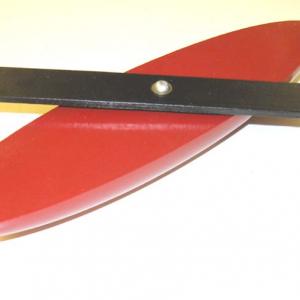College of Liberal Arts & Sciences
1M40.90 - Celts or Rattle Backs
Put the Celt on a smooth surface. Start it spinning in a clockwise direction. After a few turns it will stop and then go in its preferential counter-clockwise direction. It will also turn in a counter-clockwise direction if you just start it rocking by tapping one end.
The large Celt can be set to rotate in either direction or not at all.
- Rod Cross, "Rocking and Rolling Rattlebacks", TPT, Vol. 51, #9, Dec. 2013, p. 544.
- Steve Dail, "Rattleback Bet", TPT, Vol. 49, #5, May 2011, p. 316.
- Ronald D. Edge and Richard Childers, "Curious Celts and Riotous Rattlebacks", TPT, Vol. 37, #2, Feb. 1999, p. 80.
- H. Richard Crane, "The Rattleback Revisited", TPT, Vol. 29, #5, May 1991, p. 278.
- Jearl Walker, "The Amateur Scientist: The Mysterious 'Rattleback': A Stone That Spins in One Direction and Then Reverses", Scientific American, Vol. 241, #4, Oct. 1979, p. 172.
- Jodi and Roy McCullough, "Center of Gravity with a Celt", The Role of Toys in Teaching Physics, p. 4.114.
- Jearl Walker, "1.109. Rattlebacks", The Flying Circus of Physics Ed. 2, p. 54.
- Jearl Walker, "2.72. The Rebellious Celts", The Flying Circus of Physics with Answers.
- Christopher P. Jargodzki and Franklin Potter, "226. The Mysterious", Mad About Physics, p. 90, 226.
- Robert Ehrlich, "F.5. Rattleback", Turning the World Inside Out and 174 Other Simple Physics Demonstrations, p. 71 - 72.
- Sir Hermann Bondi, "The Rigid Body Dynamics of Unidirectional Spin", Proceedings of the Royal Society of London, Vol. 405, #1829, June 1986, p. 265 - 274.
Disclaimer: These demonstrations are provided only for illustrative use by persons affiliated with The University of Iowa and only under the direction of a trained instructor or physicist. The University of Iowa is not responsible for demonstrations performed by those using their own equipment or who choose to use this reference material for their own purpose. The demonstrations included here are within the public domain and can be found in materials contained in libraries, bookstores, and through electronic sources. Performing all or any portion of any of these demonstrations, with or without revisions not depicted here entails inherent risks. These risks include, without limitation, bodily injury (and possibly death), including risks to health that may be temporary or permanent and that may exacerbate a pre-existing medical condition; and property loss or damage. Anyone performing any part of these demonstrations, even with revisions, knowingly and voluntarily assumes all risks associated with them.

